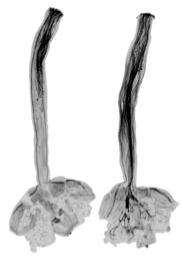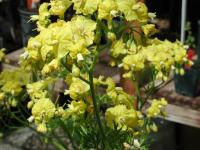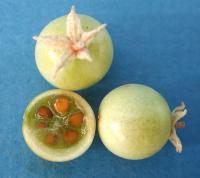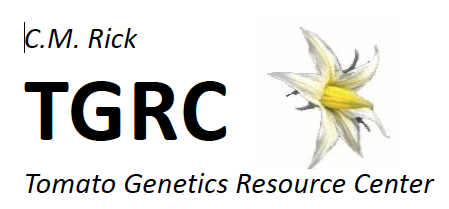Projects
The overall theme of our research is to better characterize the genetic diversity in the wild tomato relatives and to develop new populations and genetic tools that improve access to genetic variation. Our current research interests are:

Interspecific reproductive barriers. We are interested in the molecular genetics of pollen rejection by self- and unilateral interspecific incompatibility, as well as other types of interspecific reproductive barriers that prevent hybridization between related Solanum species. We showed that loss of a pollen-specific Cullin1 protein in self-compatible tomato species explains why their pollen is rejected on pistils of self-incompatible relatives (the 'SI x SC rule'). This mechanism of pollen rejection requires active S-RNase expression in the pistil. In addition we characterized pollen and pistil factors (FPS2 and ODC2, respectively) that act in an S-RNAse independent manner to bring about pollen rejection.

Wide hybridization and introgression. By manipulating or bypassing several reproductive barriers, we hybridized cultivated tomato with two of its most distantly related wild nightshade cousins, S. lycopersicoides and S. sitiens, each of which contain unique abiotic and biotic stress tolerance traits. We developed introgression line populations that capture ca. 95% of each wild species' genome in the genetic background of S. lycopersicum. We previously used these genetically-defined, breeder-friendly prebred lines to study the factors that limit recombination in wide crosses.

Pollen and seed traits related to heat stress. We are using the S. sitiens ILs described above to identify QTLs for fruit and seed set under heat stress, and for seed vigor/dormancy. We are interested in identifying genes underlying these QTLs by using CRISPR-Cas9 to mutate candidate genes.
Publications:
Quiros, C.F., R. Chetelat, and C.E. Vallejos (2023) Obituary Miguel Holle (1937–2023). Genet Resour Crop Evol. https://doi.org/10.1007/s10722-023-01658-w
Qin, X. and Chetelat, R. T. (2021) Ornithine decarboxylase genes contribute to S-RNase-independent pollen rejection. Plant Physiol. 186: 456-468
Chetelat, R. T., X. Qin, M. Tan, D. Burkart-Waco, Y. Moritama, X. Huo, T. Wills and R. Pertuze (2019) Introgression lines of Solanum sitiens, a wild nightshade of the Atacama Desert, in the genome of cultivated tomato. The Plant Journal 100: 836-850
Qin, X. , W. Li, Y. Liu, M. Tan, M. Ganal, and R.T. Chetelat (2018) A farnesyl pyrophosphate synthase gene expressed in pollen functions in S-RNase-independent unilateral incompatibility. The Plant Journal 93: 417-430.
Markova, D.N. , J.J. Petersen, S.E. Yam, A. Corral, M.J. Valle, W. Li and R.T. Chetelat (2017) Evolutionary history of two pollen self-incompatibility factors reveals alternate routes to self-compatibility within Solanum. American Journal of Botany 104: 1904-1919.
Schmidt, M. H.-W. , et al. (2017) De Novo Assembly of a New Solanum pennellii Accession Using Nanopore Sequencing. The Plant Cell 29: 2336-2348.
Baek, Y. S., S. M. Royer, A. K. Broz, P. A. Covey, G. Lopez-Casado, R. Nunez, P. J. Kear, M. Bonierbale, M. Orillo, E. van der Knaap, S. M. Stack, B. McClure, R. T. Chetelat and P. A. Bedinger (2016) Interspecific reproductive barriers between sympatric populations of wild tomato species (Solanum section Lycopersicon). American Journal of Botany 103:1964-1978.
Markova, D. N., J. J. Petersen, X. Qin, D. R. Short, M. J. Valle, A. Tovar-Mendez, B. A. McClure and R. T. Chetelat (2016) Mutations in two pollen self-incompatibility factors in geographically marginal populations of Solanum habrochaites impact mating system transitions and reproductive isolation. American Journal of Botany 103: 1847-1861.
Toal, T. W., D. Burkart-Waco, T. Howell, M. Ron, S. Kuppu, A. Britt, R. Chetelat and S. M. Brady (2016) Indel Group in Genomes (IGG) Molecular Genetic Markers. Plant Physiology 172: 38-61
Chetelat, R. T. (2016) Overcoming sterility and unilateral incompatibility of Solanum lycopersicum x S. sitiens hybrids. Euphytica 207: 319-330
Li, W. and R. T. Chetelat (2015) Unilateral incompatibility gene ui1.1 encodes an S-locus F-box protein expressed in pollen of Solanum species. PNAS 112: 4417-4422
Baek, Y.S., P.A. Covey, J. J. Petersen, R. T. Chetelat, B. McClure and P. A. Bedinger (2015) Testing the SI x SC rule: Pollen-pistil interactions in interspecific crosses between members of the tomato clade (Solanum section Lycopersicon, Solanaceae) Am. J. Bot. February 102: 302-311
F.H. Barrios-Masias, R.T. Chetelat, N.E. Grulke, L.E. Jackson (2014) Use of introgression lines to determine the ecophysiological basis for changes in water use efficiency and yield in California processing tomatoes. Functional Plant Biology 41: 119-132
Lin, T., et al. (2014) Genomic analyses provide insights into the history of tomato breeding. Nature Genetics 46: 1220-1226
Li, W. and R.T. Chetelat (2014) The role of a pollen-expressed Cullin1 protein in gametophytic self-incompatibility in Solanum. Genetics 196: 439-442
Sim, S.Ch, A. Van Deynze, K. Stoffel, D. S. Douches, D. Zarka, M. W. Ganal, R. T. Chetelat, S. F. Hutton, J. W. Scott, R. G. Gardner, D. R. Panthee, M. Mutschler, J. R. Myers, and D. M. Francis (2012) High-density SNP genotyping of tomato (Solanum lycopersicum L.) reveals patterns of genetic variation due to breeding. PLoSOne 7(9): e45520. doi:10.1371/journal.pone.0045520.
Powell, A.L.T., C. Nguyen, V., T. Hill, K.L. Cheng, R. Figueroa-Balderas, H. Aktas, H. Ashrafi, C. Pons, R. Fernandez-Munoz, A. Vicente, J. Lopez-Baltaza, C.S. Barry, Y. Liu, R. Chetelat, A. Grannell, A. Van Deynze, J.J. Giovannoni, and A.B. Bennett (2012) Uniform ripening encodes a Golden 2-like transcription factor regulating tomato fruit chloroplast development. Science 336: 1711-1715.
Tam, S.M., J.B. Hays, and R.T. Chetelat (2011) Effects of suppressing the DNA mismtach repair system on homeologous recombination in tomato. Theor. Appl. Genetics 123: 1445-1458.
Bedinger, P. A., R.T. Chetelat, et al. (2011) Interspecific reproductive barriers in the tomato clade: opportunities to decipher mechanisms of reproductive isolation. Sex. Pl. Reprod. 24: 171-187.
Grandillo, S., R. Chetelat, et al. (2011) Solanum sect. Lycopersicon. In: C. Kole (ed.), Wild Crop Relatives: Genomic and Breeding Resources, Vegetables, Springer-Verlag, Berlin Heidelberg, pp. 129-215.
Li, W. and R.T. Chetelat (2010) A pollen factor linking inter- and intraspecific pollen rejection in tomato. Science 330: 1827-1830 (Reprint | Full Text)
Li, W., S. Royer, and R.T. Chetelat (2010) Fine mapping of ui6.1, a gametophytic factor controlling pollen-side unilateral incompatibility in interspecific Solanum hybrids. Genetics 185: 1069-1080
Albrecht, E., M. Escobar and R.T. Chetelat (2010) Genetic diversity and population structure in the tomato-like nightshades Solanum lycopersicoides and S. sitiens. Annals of Botany 105: 535-554, 2010.
Albrecht, E., and R.T. Chetelat (2009) Comparative genetic linkage map of Solanum sect. Juglandifolia evidence of chromosomal rearrangements and overall synteny with the tomatoes and related nightshades. Theor. Appl. Genet. 118: 831-847.
Chetelat, R.T., R.A. Pertuze, L. Faundez, E.B.Graham, C.M. Jones (2009) Distribution, ecology and reproductive biology of wild tomatoes and related nightshades from the Atacama Desert region of northern Chile. Euphytica (2009) 167:77-93
Tam, S. M., S. Samipak, A. Britt, and R. T. Chetelat (2009) Characterization and comparative sequence analysis of the DNA mismatch repair MSH2 and MSH7 genes from tomato. Genetica 137: 341-354.
Davis, J., D. Yu, W. Evans, T. Gokirmak, R. T. Chetelat, and H. U. Stotz (2009) Mapping of loci from Solanum lycopersicoides conferring resistance or susceptibility to Botrytis cinerea in tomato. Theor. Appl. Genet. 119: 305-314
Jones, C. M., C. M. Rick, D. Adams, J. Jernstedt, and R. T. Chetelat (2007) Genealogy and fine mapping of obscuravenosa, a gene affecting the distribution of chloroplasts in leaf veins, and evidence of selection during breeding of tomatoes (Lycopersicon esculentum; Solanaceae) Amer. J. Bot. 94: 935-947.
Ji, Y., and R.T. Chetelat (2007) GISH analysis of meiotic chromosome pairing in Solanum lycopersicoides introgression lines of cultivated tomato. Genome 50: 825-833.
Canady, M.A., Y. Ji, and R.T. Chetelat (2006) Homeologous recombination in Solanum lycopersicodes introgression lines of cultivated tomato. Genetics 174: 1775-1778.
Rousseaux, M.C., C.M. Jones, D. Adams, R. Chetelat, A. Bennett and A. Powell (2005) QTL analysis of fruit antioxidants in tomato using Lycopersicon pennellii introgression line. Theor Appl Genet (2005) 111: 1396-1408
Canady, M.A., V. Meglic, and R.T. Chetelat (2005) A library of Solanum lycopersicoides introgression lines in cultivated tomato. Genome 48: 685-697
Guimaraes, R. L., Chetelat, R. T. and Stotz, H. U. (2004) Resistance to Botrytis cinerea in Solanum lycopersicoides is dominant in hybrids with tomato, and involves induced hyphal lysis. . Eur. J. Plant Path., 110, 13-23.
Ji, Y., R.A. Pertuze, R.T. Chetelat (2004) Genome differentiation by GISH in interspecific and intergeneric hybrids of tomato and related nightshades. Chrom. Res. 12: 107-116.
Pertuze, R. A., Y. Ji, and R.T. Chetelat (2003) Transmission and recombination of homeologous S. sitiens chromosomes in tomato. Theor. Appl. Genet. 107: 1391-1401.
Ji, Y., and R.T. Chetelat (2003) Homoeologous pairing and recombination in Solanum lycopersicoides monosomic addition and substitution lines of tomato. Theor. Appl. Genet. 106: 979-989.
Pertuze, R. A., Y. Ji, and R. T. Chetelat (2002) Comparative linkage map of the Solanum lycopersicoides and S. sitiens genomes and their differentiation from tomato. Genome 45: 1003-1012.
Stamova, B. S., and R. T. Chetelat (2000) Inheritance and genetic mapping of cucumber mosaic virus resistance introgressed from Lycopersicon chilense into tomato. Theor. Appl. Genet. 101: 527-537.
Chetelat, R.T., and V. Meglic (2000) Molecular mapping of chromosome segments introgressed from Solanum lycopersicoides into cultivated tomato (Lycopersicon esculentum) Theor. Appl. Genet. 100: 232-241.
Chetelat, R.T., V. Meglic, and P. Cisneros (2000) A genetic map of tomato based on BC1 Lycopersicon esculentum x Solanum lycopersicoides reveals overall homeologous genomes. Genetics 154: 857-867.
Chetelat, R.T., C.M. Rick, P. Cisneros, K.B. Alpert, and J.W. DeVerna (1998) Identification, transmission, and cytological behavior of Solanum lycopersicoides Dun. monosomic alien addition lines in tomato (Lycopersicon esculentum Mill.). Genome 41:40-50.
Chetelat, R.T., P. Cisneros, L. Stamova and C.M. Rick (1997) A male-fertile Lycopersicon esculentum x Solanum lycopersicoides hybrid enables direct backcrossing to tomato at the diploid level. Euphytica 95: 99-108.
Chetelat, R.T., J.W. DeVerna, and A.B. Bennett (1995.) Introgression into tomato (Lycopersicon esculentum) of the L. chmielewskii sucrose accumulator gene (sucr) controlling fruit sugar composition. Theor. Appl. Genet. 91: 327-333.
Chetelat, R.T., J.W. DeVerna, and A.B. Bennett (1995) Effects of the Lycopersicon chmielewskii sucrose accumulator gene (sucr) on fruit yield and quality parameters following introgression into tomato. Theor. Appl. Genet. 91: 334-339.
Chetelat, R.T., E. Klann, J.W. DeVerna, and A.B. Bennett (1993) Inheritance and genetic mapping of fruit sucrose accumulation in Lycopersicon chmielewskii. Plant Journal 4: 643-650.
Klann, E.M., R.T. Chetelat, and A.B. Bennett (1993) Expression of acid invertase gene controls sugar composition in tomato (Lycopersicon) fruit. Plant Physiol. 103: 863-870.
Yelle, S., R.T. Chetelat, M. Dorais, J.W. DeVerna, and A.B. Bennett (1991) Sink metabolism in tomato fruit. IV. Genetic and biochemical analysis of sucrose accumulation. Plant Physiol. 95: 1026-1035.
Chetelat, R.T., and J.W. DeVerna (1991) Expression of unilateral incompatibility in pollen of Lycopersicon pennellii is determined by major loci on chromosomes 1, 6 and 10. Theor. Appl. Genet. 82: 704-712.
DeVerna, J.W., C.M. Rick, R.T. Chetelat, B.J. Lanini and K.B. Alpert (1990) Sexual hybridization of Lycopersicon esculentum and Solanum rickii by means of a sesquidiploid bridging hybrid. Proc. Nat. Acad. Sci., USA 87:9486-9490.
Chetelat, R.T., C.M. Rick and J.W. DeVerna. (1989) Isozyme analysis, chromosome pairing, and fertility of Lycopersicon esculentum x Solanum lycopersicoides diploid backcross hybrids. Genome 32:783-790.
DeVerna, J.W., R.T. Chetelat and C.M. Rick. (1987) Cytogenetic, electrophoretic and morphological analysis of progeny of sesquidiploid Lycopersicon esculentum-Solanum lycopersicoides hybrids x L. pennellii. Biologisches Zentralblatt 106:417-428.
DeVerna, J.W., R.T. Chetelat, C.M. Rick and M.A. Stevens (1987) Introgression of Solanum lycopersicoides germplasm. pp. 27-36. In: D.J. Nevins and R.A. Jones (eds.) Tomato Biotechnology Symposium, Davis, CA, August 1986. Alan R. Liss, NY.
